Disneyland Paris (Marne-le-Vallée, France)

Opened: April 12, 1992
Background: The park formerly known as Euro Disneyland opened in 1992 as the would-be legacy-leaving project of then-CEO Michael Eisner. (It ended up… well… derailing every Parks project in development for a decade.)
Unlike Tokyo’s carbon-copied park importing Americana to the Far East, the French weren’t exactly thrilled with Disney’s “commercial invasion” or the construction of a “cultural Chernobyl” outside the City of Lights. Faced with substantial resistance to the very existence of the park, Imagineers designed Disneyland Paris to minimize the inherently American concept and to emphasize the park’s more romantic, literary, and epic aspects.
In other words, thirty years after Magic Kingdom, Imagineers had their first real chance to reconsider for themselves what a Disneyland-style park could be. Passed through the lens of European tastes, the park is pretty definitively the most beautiful “Castle Park” on Earth. Weirdly, that’s even reflected in its pathways…
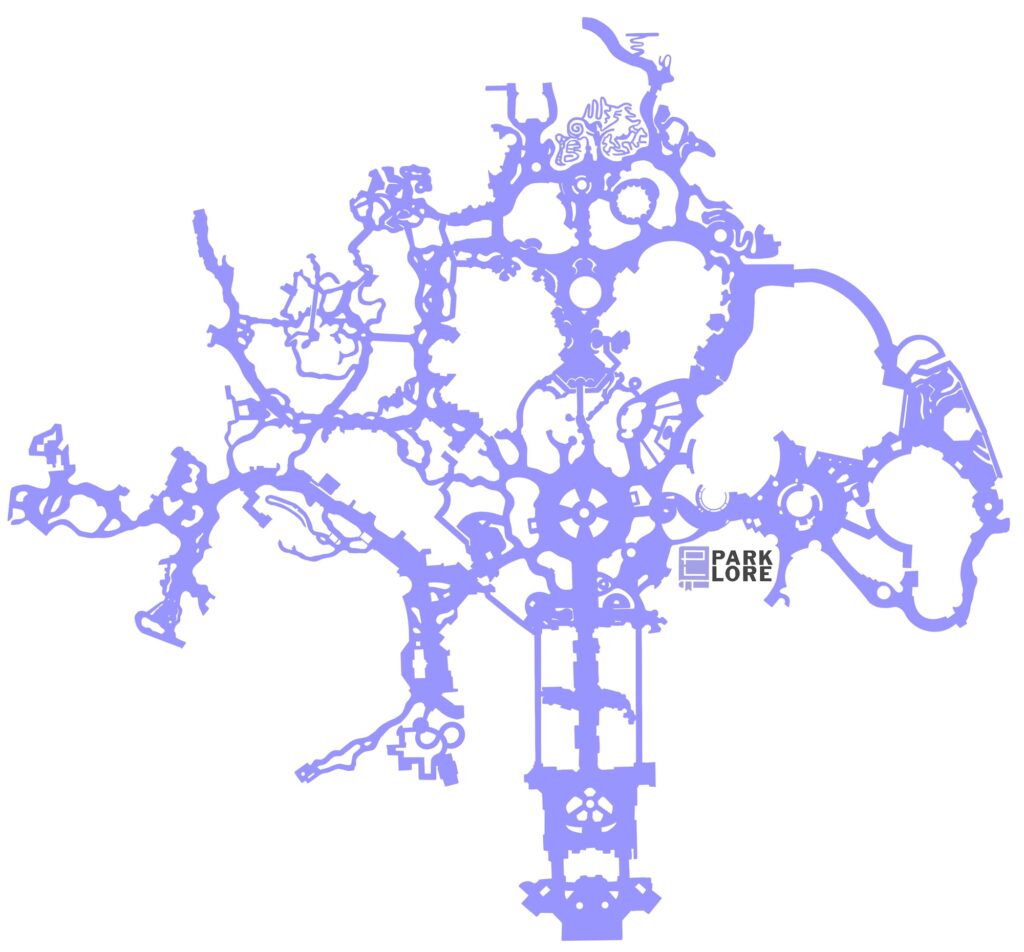
Pathways: Disneyland Paris was the first “Castle Park” to break with many tried-and-true conventions. For example, since the French would find no nostalgia in a mid-century American Space Race, Tomorrowland was replaced with Discoveryland – a retro-futuristic, golden, timeless land devoted to the steampunk-stylized futures envisioned by great European authors, anchored by the Lost Legends: Le Visionarium and Space Mountain: De la Terre á la Lune. Even from the air, you can see how the land is softer, rounder, and earthier than the rigid Tomorrowlands elsewhere.
Disneyland Paris also swapped the locations of Adventureland and Frontierland (the definitive Big Thunder Mountain is located in the former, occupying the center of the “Rivers of the Far West” and tied to the Modern Marvel: Phantom Manor) and broke up the traditional Fantasyland into a multi-tiered figure-8 layout.
More to the point, though, Disneyland Paris is often described as a park that perfectly blends the scale, efficiency, and grandeur of Magic Kingdom with the coziness and storybook warmth of Disneyland. The park’s pathways perfectly demonstrate why. Fully insulated lands are connected by dozens of arterial paths, broken up by trees and rockwork. There are spaces to get lost; to relax; to be alone! Disneyland Paris offers capacity without bulk. Incredibly intricate, the park is a “Bucket List” destination for Imagineering fans for good reason.
Hong Kong Disneyland (Lantau Island, Hong Kong)
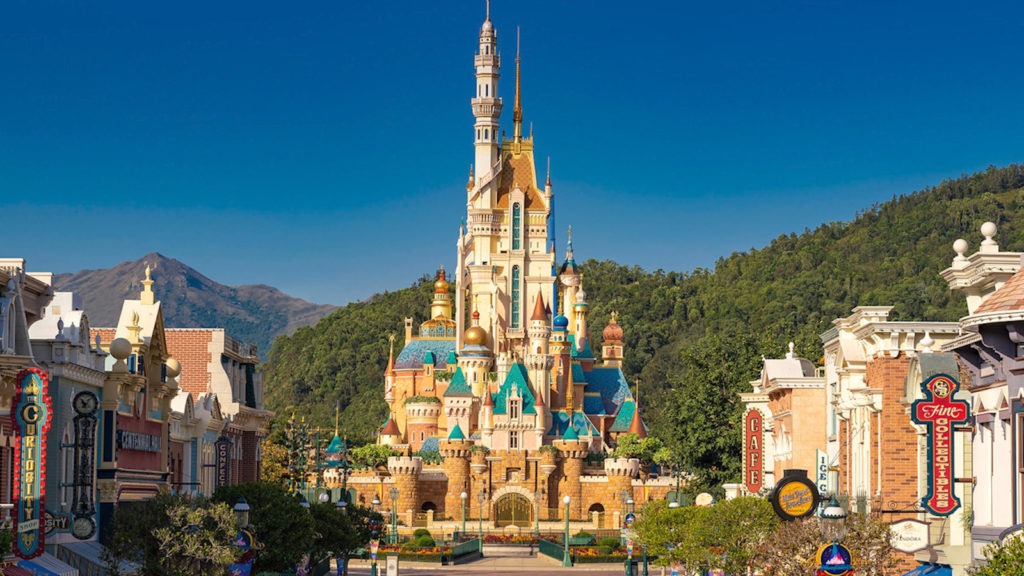
Opened: September 12, 2005
Background: Hong Kong Disneyland opened in 2005 – the same year then-CEO Michael Eisner left the company ahead of his contract’s expiration. Not-so-coincidentally, it was the third in a trifecta of underbuilt parks in the era that each necessitated billion dollar rebuilds in the 2010s. (We dove into the in-depth stories of the other two – Disney’s California Adventure and Walt Disney Studios Park – in standalone, full-length features).
Rather than reinventing, reimagining, or reinterpreting the “Castle Park” formula as Disneyland Paris had, Hong Kong Disneyland was essentially a replica of Anaheim’s Disneyland… without its E-Tickets. There was no Big Thunder Mountain. No Haunted Mansion. No Pirates. No Peter Pan’s Flight. No “it’s a small world.” Only one dark ride made it into the park’s Fantasyland (The Many Adventures of Winnie The Pooh), and its only E-Ticket was Space Mountain. The park had absolutely nothing one-of-a-kind or even unique.
Instead, the tiny park contained just four lands – Main Street, Adventureland, Fantasyland, and Tomorrowland – each little more than a miniature plaza. (You can still divine the original park layout in the illustration below – Main Street, the Hub, and the heart-shaped core of the park, with previously-dead-end plazas for Adventureland and Tomorrowland branching off.)
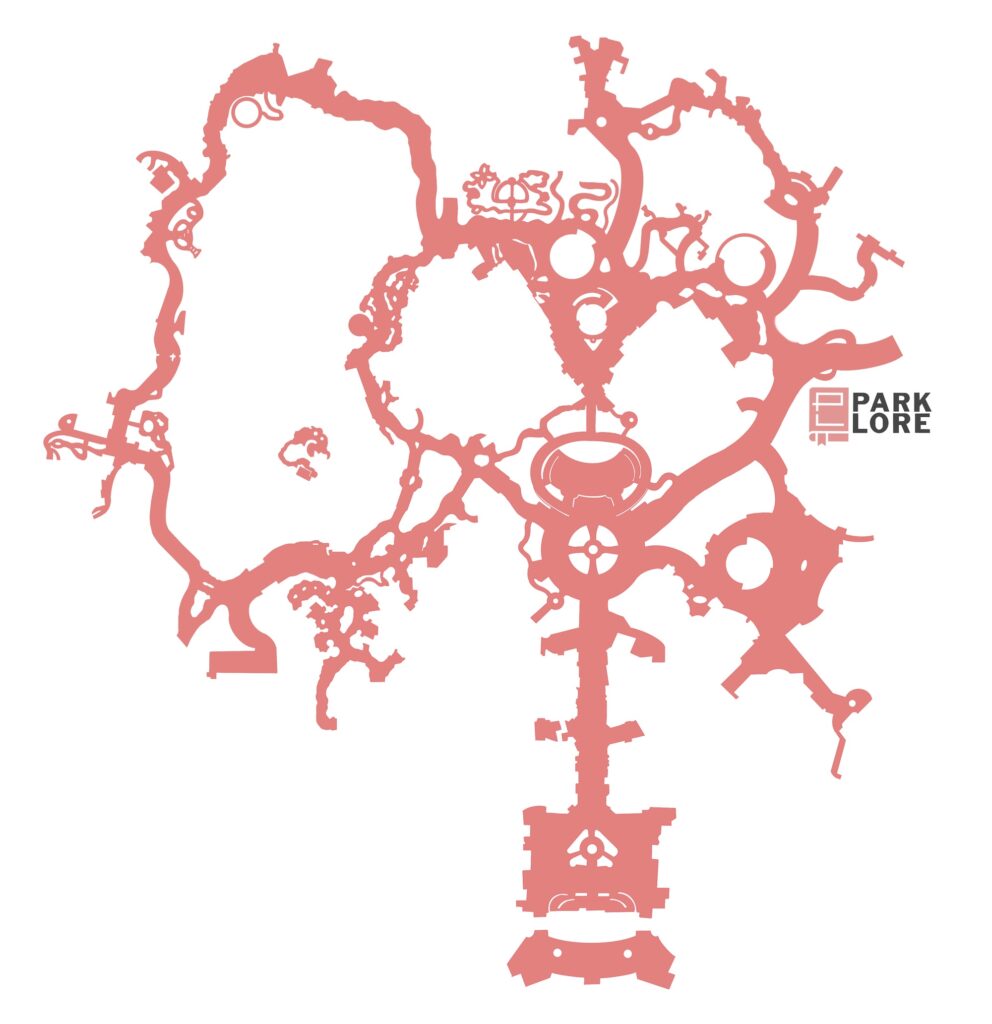
Pathways: Of course, today’s layout of Hong Kong Disneyland shows just how much has changed. In 2009, Disney announced that the park would receive a massive multi-year expansion in the form of three new mini-lands arranged as an “outer loop” beyond the park’s Railroad. (A complete “outer loop” connecting around the far side of the equivalent of the Rivers of America was unprecedented at the time, and remained so until Disneyland did the same with 2019’s Star Wars: Galaxy’s Edge.)
Those three lands were Toy Story Land, Grizzly Gulch, and Mystic Point (whose starring Modern Marvel: Mystic Manor finally gave the park something both noteworthy and exclusive). Of course, just as that expansion wrapped up, Disney began work on another Chinese park. Packed with brand new, exclusive, original E-Tickets, Shanghai Disneyland was set to be the opposite of the low-budget, play-it-safe Hong Kong Disneyland…
As a result, Hong Kong Disneyland’s majority owner (the Hong Kong government) allegedly returned to Disney demanding that their expansion in Hong Kong continue lest it become a flyover Disney Park once more. The result was another three-pronged expansion: the “embiggening” of the park’s castle, the annexation of part of Tomorrowland to create a first-of-its-kind Marvel sub-section, and another “outer loop” – this time, The World of Frozen branching off of Fantasyland.
As a result, it’s hard to call Hong Kong Disneyland’s pathways “beautiful” or “intentional.” Just the opposite, they tell the story of a park that’s inventing as it goes, defying norms, and adding lands in something of a “piecemeal” approach. Whether you “agree” with the park’s unique evolution or not, it’s pretty cool to see Hong Kong Disneyland throw off the chains of the past and just try something new to stay notable.
Shanghai Disneyland (Shanghai, China)
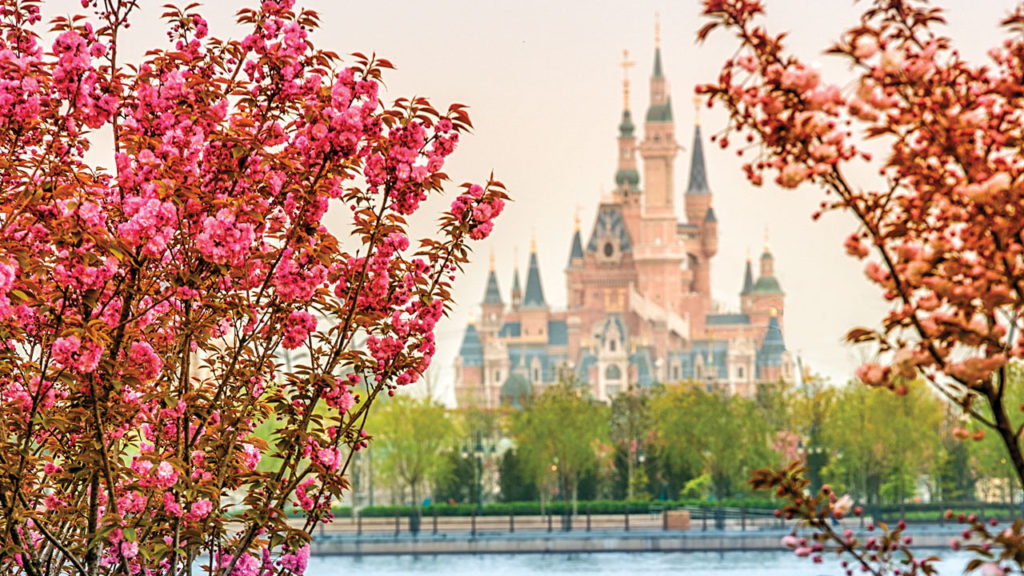
Opened: June 16, 2016
Background: If Hong Kong Disneyland was a low-budget throwback, Shanghai Disneyland was a future-ready reinvention. The park opened in 2016 as the culmination of then-CEO Bob Iger’s long game effort to bring Disney Parks, Experiences, and Consumer Products to China’s 1.4 billion citizens. Banking on the country’s bend toward (skeptical) permissiveness of Western culture in the 2010s, Iger’s Shanghai Disneyland would serve as an introduction to and anchor of Disney’s brand for an emerging middle class hungry for new experiences.
Extravagant in a way not seen since Disneyland Paris a quarter century earlier, Shanghai Disneyland wasn’t just a return to form for Disney Parks. It was also a reinvention. Culturally, Imagineers stripped much of the Americana out of the Disneyland concept (no “ideals, dreams, and hard facts that created America” here!) and purposefully omitted nearly every tried-and-true staple ride you’d expect in a Disneyland-style park. Instead, Shanghai would introduce a new generation of rides based on modern Disney franchises.
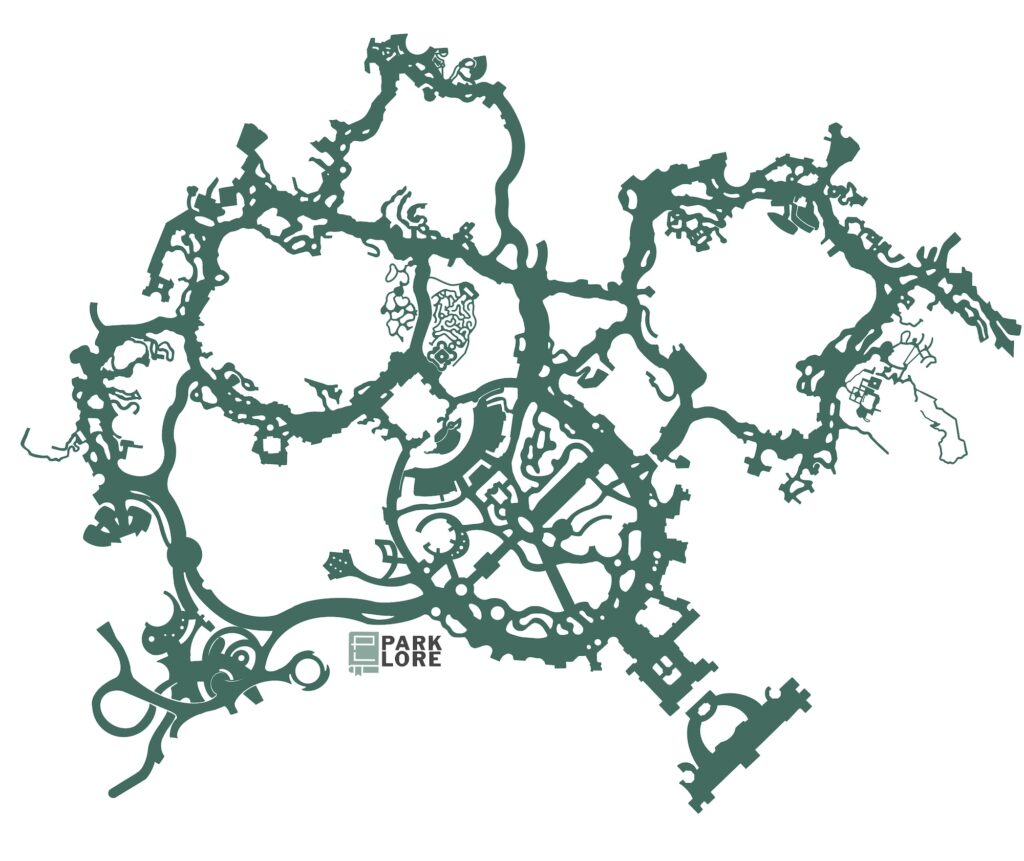
Pathways: If form follows function, then it makes sense that Shanghai Disneyland barely maps onto the framework you expect of a “Castle Park”… The hub has been inflated into a standalone land – the Gardens of Imagination – meant to cater to China’s aging population and counter its urban sprawl. Main Street has morphed into Mickey Avenue (probably best described as a hybrid of Buena Vista Street and Toontown) – a Disney Characters 101 introduction for China’s multi-generational families.
Tomorrowland has swapped sides and taken on an entirely new form (an elevated, abstract plaza of glass and steel, loomed over by the canopy of the Modern Marvel: TRON Lightcycle Power Run). Two new lands – Adventure Isle and Treasure Cove – share a lagoon to the right of the “Hub.” Two expansion pads have already been activated by way of 2018’s Toy Story Land and 2023’s Zootopia. (It may seem random, but the 2016 film Zootopia was outsized hit in China.) Only the presence of a central Castle (Disney’s largest) and Fantasyland beyond even really signal that this is a “Disneyland.”
Even though its contents have changed quite a bit, it’s easy to see the influence of other “Castle Parks.” Like Florida, there’s a clear circuitous route; as in Tokyo, wide plazas serve as joints between lands; yet just like Paris, wide paths aren’t bulky, but broken up by planters and meandering trails that serve as pressure release valves. What the paths alone don’t show is that Shanghai Disneyland is also littered with expansion pads from small banks of trees to gargantuan plots that could one day house several Galaxy’s Edge-sized lands.
Member Extra: Setting California’s Disneyland against China’s at the same scale (for Members, above), they might as well be two entirely different concepts. But looking at the many iterations between the Anaheim original and Shanghai’s next-generation sneak peek tells the subtle story of a theme park’s invention, expansion, translation, reimagining, replication, and evolution. But Disney’s six “Castle Parks” only tell a part of the story…
Read on as we examine Epcot and the “Studio” Parks from above…



